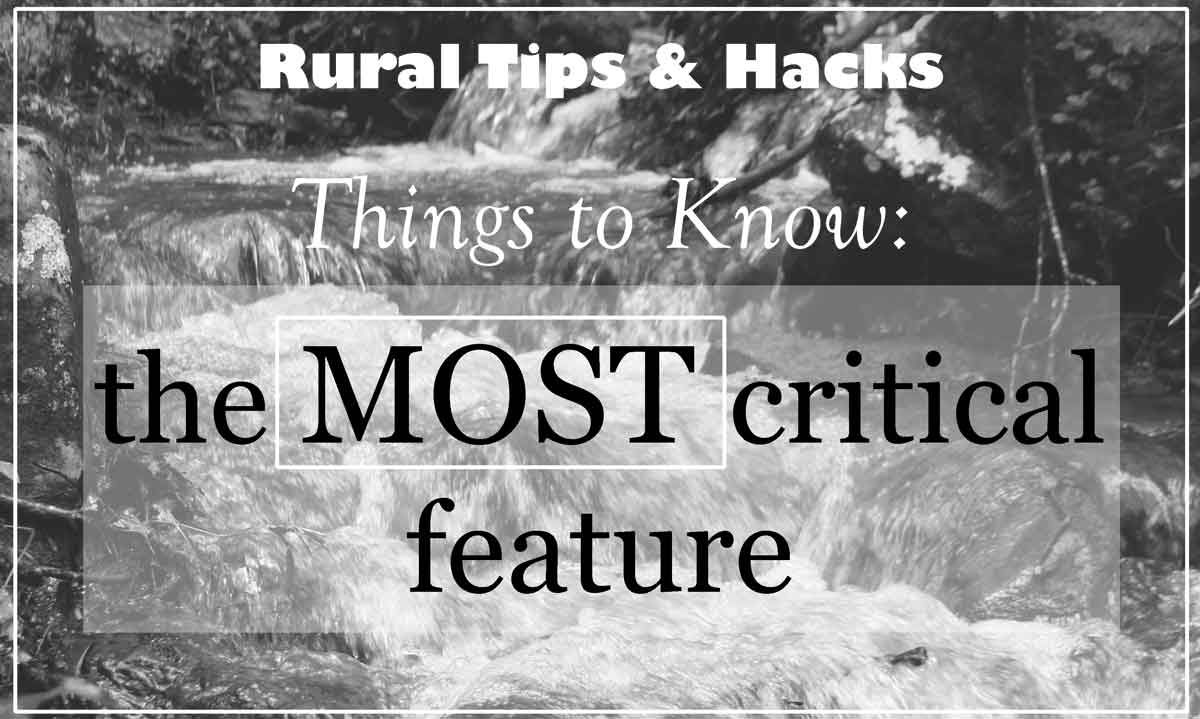The title sums it up. Water is the most critical feature of any land consideration – if you’re intending to use it for staying on it more than camping/hunting.
Access to water
To refine this further, it is actually the ACCESS to water that makes the biggest difference. Location of the water source is what contributes most to accessibility. If it’s on your own land, that’s best. But even more, it needs to be somewhere that you can reach.
Water Sources
Water availability, and access to it will make the difference in whether or not you can expect to survive long-term on your land. Everything else is easier to bring in from off-site or remedy later on-site. But water is either accessible or it isn’t.
- Rain
- Spring
- Surface
- Haul-in
- Ground
- Municipal
Rain Water – adequate storage is key
Rainwater collection is a viable way to have access to water for everything except drinking. We get annual rainfalls enough to provide year-round water if you have enough storage to get through the dry spells, and you’re careful with usage.
If the tanks aren’t at an elevation higher than your house, you’ll need a pump to move the water, which means solar or electricity also needs to be available.
Without treatment, rainwater won’t be safe to drink.
Spring Water
A year-round spring is a tremendous boon, and even moreso if that spring exits the ground at least 100 feet above your home. This is the setup we have here – the spring is about 300 feet up the mountain. We have a 1500 gallon storage tank about 100-200 feet above the house, below the spring.
It’s not a high-output spring, but makes a gallon every three minutes or so. It does this without fail even during the longest, driest droughts. Learning to ration water during freezes or droughts is a good rural-life skill to learn.
Click here to read a post about our spring water system, and one of the issues we have sometimes.
Surface Water

Surface water includes creeks, ponds, or lakes. Spring-fed surface water is ideal because it means a constant influx of fresh water. It’s important that the springs flow year-round, though. A dry pond or creek isn’t much good when the water is a foot or two beneath the ground. However, it is sometimes possible to at least hand-dig access to water in these cases.
A creek is wonderful. But if the creek is at the bottom of a deep ravine, you’ll need to get creative with how to get some of that water up to your house.
Most of the time, surface water will require a pump. If you’re off-grid, you’ll need solar with a battery backup if you want to move the water at night or during inclement weather. An alternative is to put a water storage tank at a higher elevation and pump it to the tank whenever you can.
Haul In
In rural areas there are sometimes filling stations where you can fill truck tanks. These are plastic water storage tanks that fit in the back of a pickup truck.
Many people who don’t have reliable water sources haul water as needed and then pump it into a holding tank.
This is not the best solution, but it works. You’ll want to be sure to stock up on water before winter storms or rain events that might keep you flooded in at your home.
Ground Water – drill or dig a well
There might be an existing hand-dug well on many properties here in the rural parts of northwest Arkansas. These are not usually very deep, but can provide a source of water for basic necessities except drinking.
Sometimes it’s possible to install a well. Know in advance that getting a well drilled is a significant expense that increases the deeper the water is. Out here it can cost $20K or more. Also know there’s no guarantee there will actually be water to access. Most well drillers have a pretty good idea whether there will be water, and approximately how far they’ll have to drill.
The other thing to be aware of regarding a drilled well is that we have a layer of shale in many areas. If the driller has to go through the shale, then it’s very likely your water will stink like rotten eggs. The smell is bad, but the water may be still drinkable (no harmful bacteria) and can be treated to remove the smell.
If you are able to get a well drilled, there is also the collection and distribution of the water to contend with. Most people install a tank and pump. Some off-grid locations try to have the well drilled at a higher elevation than the house, so they can eliminate the need to pump it. This is a good idea also if you want water availability even without electricity (solar or otherwise).
Municipal Water
This is what most people are accustomed to. There’s a large water tank somewhere in the area and water companies distribute the water to residents.
Many rural areas in northwest Arkansas do not have access to this service. But if ‘survival’ is your goal, then you’ll want an independent source of water at all possible.
Storing Water

That creek you rely on needs to hold water year-round unless you’ll also rely on extra storage as you would with rain water. It’s the same with groundwater here in the Ozarks. A shallow well might go dry during droughts, so you’ll want storage for that, too. Many springs are the same way.
Fortunately, water storage tanks are a common sight in the yards of hardware stores in this area. They come in a variety of sizes. Some are even shaped to fit conveniently in the back of a pick-up truck for easier hauling.
Clean Water
Any water source is better than none, but the only sources that will allow you to drink without treatment of some sort will be municipal (Sometimes. I’ve received boil orders often enough when I lived an urban life to not trust municipal all of the time either) and a deep well that has been tested to show it’s free of harmful bacteria and nutrients (nitrogen/phosphates).
Ultimately, CLEAN drinking water is the most critical resource.
We have spring water here at the Wild Ozark homestead. During my days behind the bench of laboratories, I tested our water frequently. It’s free of coliforms/e-coli, nitrates, and phosphates. But it is still a ‘living’ water. It’s full of other bacteria. And because the source of our spring is unknown, it could be at risk of exposure to other pathogens without notice.
So we have a 5-gallon water dispenser that we use for drinking water and get our jugs filled when we go to town. A Berkey filter would probably work just fine to filter if we didn’t or couldn’t do that. However, our water is on the acidic side and is low in calcium and magnesium. If I used it for drinking all of the time, I’d want to address those issues.
If pond, creek, or rainwater is your source, more filtration and treatment would likely be needed in order to drink it.
Access to Water in Winter
This wasn’t something I knew I needed to worry about when I first moved to the Ozarks. Before, I lived in an urban area. We had a well, and water always came on when I opened a faucet.
Moving to a much more rustic way of life meant learning a lot about how reliable our water system is during the winters. Here’s a post I wrote about that in 2016. You’ll want to learn how to make repairs to water lines, especially in winter.

In Summary
Water is the most critical resource to consider when choosing remote properties in the Ozarks. It shouldn’t be left as an afterthought. There are options to choose from, depending on your needs, but municipal isn’t usually one of them unless your land is closer to a town.


Leave a Reply